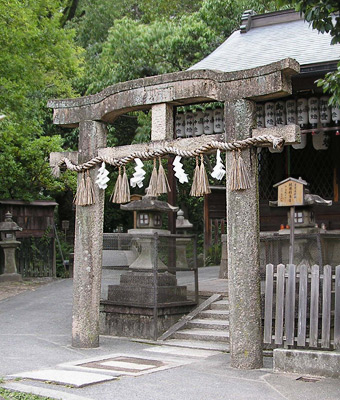|
||
 |
||

Itsukushima
Jinja 厳島神社 (Kyoto)
(C)2001 Japanese Architecture and Art Net Users System. No reproduction or republication without written permission.
掲載のテキスト・写真・イラストなど、全てのコンテンツの無断複製・転載を禁じます。
|
||||||
| karahafu torii 唐破風鳥居 | ||||||
| KEY WORD : architecture / shrines | ||||||
| A unique Shinto gate *torii
鳥居 in Kyoto, called itsukushima torii 厳島鳥居. It is named for its undulating
top and secondary lintels *kasagi
笠木 and *shimaki 島木, which
resemble the undulating gable *karahafu
唐破風, associated with traditional architecture from the 16c and after. The pillars
do not have base stones and rise from the ground with a slight inward incline
*uchikorobi 内転. The pillar's
diameter is greater than the width of the secondary lintel and the tie beam *nuki
貫 is almost square in section and is composed of a single center piece penetrating
the inner face. The outer extensions are inserted separately into the outer faces
of the pillars and extend until their ends are about even with the ends of the
top lintel. A strut, gakutsuka 額束, about the same width as the tie beam
is placed at its center connecting the tie beam and the secondary lintel. There
are indications that severe cracks appeared in the secondary lintel of the karahafu
torii and they have been filled with an adhesive creating the suggestion of
a separate block having been inserted into the member just above the strut. The
ends of the secondary lintel curve up slightly: the under curve beginning just
beyond the inner face of the pillars. In section, the secondary lintel is a wide
rectangle. The top lintel is parallel to the secondary lintel but the ends of
the top lintel extend well beyond the secondary. It is slightly peaked making
it pentagonal in section. The ends of all members are straight-cut. Example: Itsukushima
Jinja 厳島神社, Kyoto. |
||||||
 Itsukushima
Jinja 厳島神社 (Kyoto)
|
||||||
| REFERENCES: | ||||||
| EXTERNAL LINKS: | ||||||
| NOTES: | ||||||
(C)2001 Japanese Architecture and Art Net Users System. No reproduction or republication without written permission. 掲載のテキスト・写真・イラストなど、全てのコンテンツの無断複製・転載を禁じます。 |
||||||